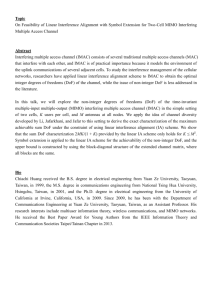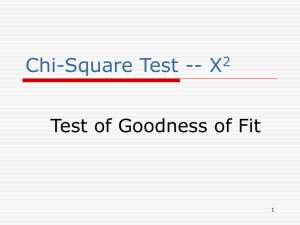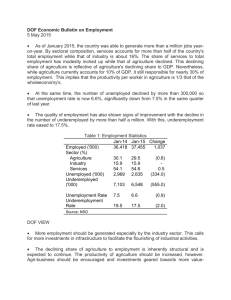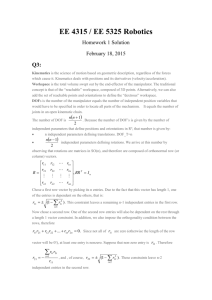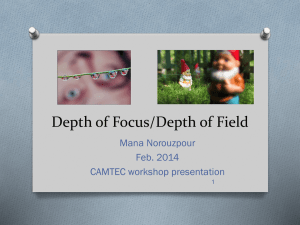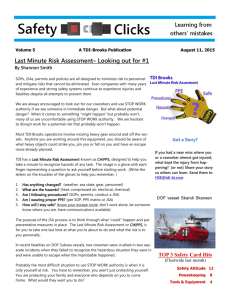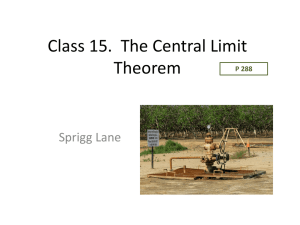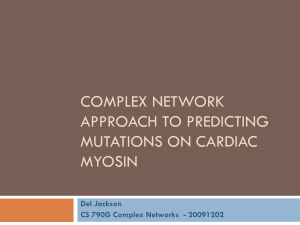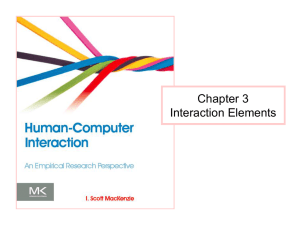Facial Expressions & Rigging - Computer Graphics Laboratory at
advertisement
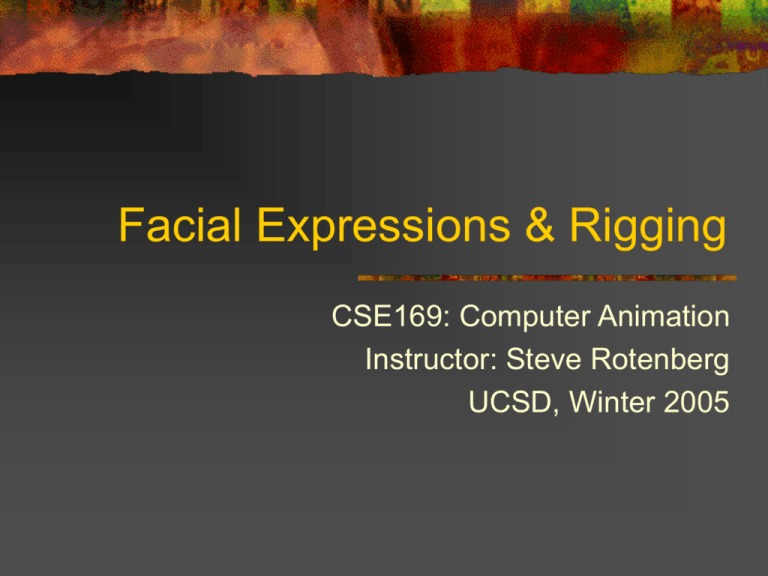
Facial Expressions & Rigging
CSE169: Computer Animation
Instructor: Steve Rotenberg
UCSD, Winter 2005
Facial Muscles
‘Universal’ Expression Groups
Sadness
Anger
Happiness
Fear
Disgust
Surprise
FACS
Facial Action Coding System (Ekman)
Describes a set of ‘Action Units’ (AUs) that correspond
to basic actions (some map to individual muscles, but
other involve multiple muscles, or even joint motion)
Examples:
1. Inner Brow Raiser
2. Outer Brow Raiser
14. Dimpler
17. Chin Raiser
19. Tongue Out
20. Lip Stretcher
29. Jaw Thrust
30. Jaw Sideways
31. Jaw Clencher
(Frontalis, Pars Medialis)
(Frontalis, Pars Lateralis)
(Buccinator)
(Mentalis)
(Risoris)
FACS
Expressions are built from basic action units
Happiness:
1. Inner Brow Raiser
6. Cheek Raiser
12. Lip Corner Puller
14. Dimpler
(Frontalis, Pars Medialis)
(Orbicularis Oculi, Pars Orbitalis)
(Zygomatic Major)
(Buccinator)
Emotional Axes
Emotional states can
loosely be graphed on
a 2-axis system
X=Happy/Sad
Y=Excited/Relaxed
Facial Expression Reading
Books
“The Artist’s Complete Guide to Facial
Expression” (Faigin)
“The Expression of Emotions in Man and
Animals” (Darwin)
“Computer Facial Animation” (Parke, Waters)
Papers
“A Survey of Facial Modeling and Animation
Techniques” (Noh)
Shape Interpolation
Bone Based Methods
Using joints & skinning to do the jaw bone
and eyeballs makes a lot of sense
One can also use a pretty standard
skeleton system to do facial muscles and
skin deformations, using the blend weights
in the skinning
This gives quite a lot of control and is
adequate for medium quality animation
Shape Interpolation Methods
One of the most popular methods in practice is
to use shape interpolation
Several different key expressions are sculpted
ahead of time
The key expressions can then be blended on
the fly to generate a final expression
One can interpolate the entire face (happy to
sad) or more localized zones (left eyelid, brow,
nostril flare…)
Shape Interpolation
Shape interpolation allows blending between several
pre-sculpted expressions to generate a final expression
It is a very popular technique, as it ultimately can give
total control over every vertex if necessary
However, it tends to require a lot of set up time
It goes by many names:
Morphing
Morph Targets
Multi-Target Blending
Vertex Blending
Geometry Interpolation
etc.
Interpolation Targets
One starts with a 3D model for the face in a
neutral expression, known as the base
Then, several individual targets are created by
moving vertices from the base model
The topology of the target meshes must be the
same as the base model (i.e., same number of
verts & triangles, and same connectivity)
Each target is controlled by a DOF Фi that will
range from 0 to 1
Morph Target DOFs
We need DOFs to control the interpolation
They will generally range from 0 to 1
This is why it is nice to have a DOF class
that can be used by joints, morph targets,
or anything else we may want to animate
Higher level code does not need to
distinguish between animating an elbow
DOF and animating an eyebrow DOF
Shape Interpolation Algorithm
To compute a blended vertex position:
v vbase i vi
where vi vi vbase
The blended position is the base position plus a
contribution from each target whose DOF value
is greater than 0 (targets with a DOF value of 0
are essentially ‘off’ and have no effect)
If multiple targets affect the same vertex, their
results combine in a ‘reasonable’ way
Weighted Blending & Averaging
Weighted sum:
x wi xi
i 0
Weighted average:
w
i 0
i
1
Convex average:
0 wi 1
Additive blend:
x x0 wi xi x0
i 1
1 wi x0 wi xi
i 1
i 1
Additive Blend of Position
• v14
• v´
• vbase
• v6
Φ6=0.5
Φ14=0.25
Normal Interpolation
To compute the blended normal:
n* nbase i ni nbase
*
n
n *
n
Note: if the normal is going to undergo further
processing (i.e., skinning), we might be able to
postpone the normalization step until later
Shape Interpolation Algorithm
To compute a blended vertex position:
v v base i v i v base
The blended position is the base position plus a
contribution from each target whose DOF value is
greater than 0
To blend the normals, we use a similar equation:
n nbase i ni nbase
We won’t normalize them now, as that will happen later
in the skinning phase
Shape Interpolation and Skinning
Usually, the shape interpolation is done in
the skin’s local space
In other words, it’s done before the actual
smooth skinning computations are done
Smooth Skin Algorithm
The deformed vertex position is a weighted average over all of the joints that the
vertex is attached to. Each attached joint transforms the vertex as if it were rigidly
attached. Then these values are blended using the weights:
1
v wi v Bi Wi
Where:
Note:
v’ is the final vertex position in world space
wi is the weight of joint i
v is the untransformed vertex position
Bi is the binding matrix (world matrix of joint i when the skin was initially attached)
Wi is the current world matrix of joint i after running the skeleton forward kinematics
B remains constant, so B-1 can be computed at load time
B-1·W can be computed for each joint before skinning starts
All of the weights must add up to 1:
w 1
i
Smooth Skinning Normals
Blending normals is essentially the same, except
we transform them as directions (x,y,z,0) and
then renormalize the results
n* win Bi1 Wi
n*
n *
n
Equation Summary
Skeleton
Morphing
L L jnt 1 , 2 ,..., N
W L Wparent
v v base i v i v base
n n base i n i n base
1
v wi v B i Wi
Skinning
n* wi n B i1 Wi
n*
n *
n
Target Storage
Morph targets can take up a lot of memory. This is a big
issue for video games, but less of a problem in movies.
The base model is typically stored in whatever fashion a
3D model would be stored internally (verts, normals,
triangles, texture maps, texture coordinates…)
The targets, however, don’t need all of that information,
as much of it will remain constant (triangles, texture
maps…)
Also, most target expressions will only modify a small
percentage of the verts
Therefore, the targets really only need to store the
positions and normals of the vertices that have moved
away from the base position (and the indices of those
verts)
Target Storage
Also, we don’t need to store the full position and
normal, only the difference from the base
position and base normal
i.e., other than storing v3, we store v3-vbase
There are two main advantages of doing this:
Fewer vector subtractions at runtime (saves time)
As the deltas will typically be small, we should be
able to get better compression (saves space)
Target Storage
In a pre-processing step, the targets are created
by comparing a modified model to the base
model and writing out the ‘difference’
The information can be contained in something
like this:
class MorphTarget {
int NumVerts;
int Index [ ];
Vector3 DeltaPosition [ ];
Vector3 DeltaNormal [ ];
}
Colors and Other Properties
In addition to interpolating the positions
and normals, one can interpolate other
per-vertex data:
Colors
Alpha
Texture coordinates
Auxiliary shader properties
Vascular Expression
Vascular expression is a fancy term to describe
blushing and other phenomena relating to the
color change in the face
Adding subtle changes in facial color that relate
to skin distortion can help improve realism
This can be achieved either by blending a color
values with every vertex (along with the position
and normal)
Alternately, one could use a blush texture map
controlled by a blended intensity value at each
vertex
Wrinkles
One application of auxiliary data interpolation is adding wrinkles
Every vertex stores an auxiliary property indicating how wrinkled
that area is
On the base model, this property would probably be 0 in most of the
verts, indicating an unwrinkled state
Target expressions can have this property set at or near 1 in wrinkled
areas
When facial expressions are blended, this property is blended per
vertex just like the positions and normals (but should be clamped
between 0 and 1 when done)
For rendering, this value is used as a scale factor on a wrinkle
texture map that is blended with the main face texture
Even better, one could use a wrinkle bump map or displacement
map
Artificial Muscle Methods
With this technique, muscles are modeled
as deformations that affect local regions of
the face
The deformations can be built from simple
operations, joints, interpolation targets,
FFDs, or other techniques
Artificial Muscles
Facial Features
Key Facial Features
Deformable Skin
Hair
Eyes
Articulated Jaw (teeth…)
Tongue
Inside of mouth
Each of these may require a different technical
strategy
Facial Modeling
Facial Modeling
Preparing the facial geometry and all the
necessary expressions can be a lot of work
There are several categories of facial modeling
techniques
Traditional modeling (in an interactive 3D modeler)
Photograph & digitize (in 2D with a mouse)
Sculpt & digitize (with a 3D digitizer)
Scanning (laser)
Vision (2D image or video)
Traditional Modeling
Photograph & Digitize
Sculpt & Digitize
Laser Scan
Computer Vision
Project 2 Extra Credit
Textures in .skin file
The modified version of the .skin file with texture
information will have an array of 2D texture coordinates
after the array of normals
texcoords [numverts] {
[tx] [ty]
}
If will also have a material definition that references a
texture map. This will appear before the triangle array
material [mtlname] {
texture [texname]
}
Morph File
positions [numverts] {
[index] [x] [y] [z]
}
normals [numverts] {
[index] [x] [y] [z]
}
Note: numverts and the indexing will match (it’s done this
way to support a possible extension where they wouldn’t
match, but don’t worry about that)
Rigging
Rigging
A rig is like a virtual puppet
A rig contains has several DOFs, each
corresponding to an animatable parameter
within the puppet
DOFs can control:
Joint rotations, translations
Morph targets
Other things…
Higher level animation code will specify values
for the DOFs (i.e., pose the rig)
Rigging
Ultimately, the rig takes DOF values from the
animation system and generates the posed
geometry of the character in world space
This might involve:
Computing world joint matrices (posing the skeleton)
Interpolating verts in local space (morphing)
Transforming verts to world space (skinning)
This geometry is then rendered through a
rendering system (OpenGL…)
Rigging and Animation
Animation
System
Pose
Rigging
System
Triangles
Renderer
Rig Data Flow
Φ 1 2 ... N
Rigging
System
v, n
Skeleton, Morph, & Skin Data Flow
1
2 ... M
L L jnt 1 , 2 ,..., m
M 1
M 2 ... N
v v base i v i v base
n n base i n i n base
W L Wparent
v wi v B i1 Wi
n* wi n B i1 Wi
n*
n *
n
v, n
Layered Approach
We use a simple layered approach
Skeleton Kinematics
Shape Interpolation
Smooth Skinning
Most character rigging systems are based
on some sort of layered system approach
combined with general purpose data flow
to allow for customization
Equation Summary
Skeleton
Morphing
L L jnt 1 , 2 ,..., N
W L Wparent
v v base i v i v base
n n base i n i n base
1
v wi v B i Wi
Skinning
n* wi n B i1 Wi
n*
n *
n
DOF Mapping & Expressions
DOF Types
In addition to controlling joints and morph
targets, DOFs can be extended to manipulate
any high level parameter that the animator
wants to control
One could make DOFs to:
Turn the character green
Extend/flex all fingers in a hand simultaneously
Make the character’s hair stand up
Morph the character from a man into a hairy monster
Control the intensity of a light
Control the creation rate of a particle system
Full Body Morphing
One can also rig up a DOF to morph an entire
character (say from a human to a giant hairy
monster)
Morphing is made easier if the topology of the
two characters matches (both skeleton & skin
topology)
To do this, one must interpolate a lot of data:
Skin positions & normals
Skin weights & attachment info
Bone offsets
Texture maps, other visual properties
Other stuff…
Grouping DOFs
You can have one DOF control several properties. For
example:
A DOF that makes all of the joints in a finger flex or extend
simultaneously
Elbow DOF that controls both the elbow rotation and a morph
target for the bicep deformation
Head DOF that rotates several vertebra in the neck
Retract DOF that controls a landing gear retraction
DOF to control a highly constrained mechanical system
Smile DOF that controls several individual muscles
For flexibility, it’s nice to be able to have the master DOF
range from say 0…1 and allow each slave DOF to scale
that number if necessary
For more flexibility, you can use expressions…
Grouping DOFs
DOF Expressions
For more flexibility, its nice to be able to run
arbitrary expressions with DOF values
An expression takes one or more DOFs as
inputs and sets an external DOF as output
An expression can literally be any mathematical
expression:
DOF[27] = DOF[3] * 6.0 – sin (DOF[2]) + DOF[14]
Rather than being hard-coded in C++, it’s nice if
expressions can be interpreted at runtime
DOF Mappings
A rig can be implemented as an array of pointers to
DOFs
The DOF order is important and must be consistent
between the rigging & animation systems
The DOFs themselves exist as internal objects used in
the skeleton, morph system, and in expressions
Normally, we would have a single rig that controls all of
the character’s DOFs that we wish to animate
Alternately, we could:
Have a rig that controls a subset of a character’s DOFs
Have one rig that maps to more than one character
Have several different rigs for the same character to be used for
different purposes
Push vs. Pull
There are lots of different ways to implement
rigging
One approach is to have the rig ‘push’ data into
the DOFs. The other is to have the DOFs ‘pull’
data from the rig. There are several other subtle
details to work out…
Pushing is probably better, as it allows for
multiple rig configurations to map to the same
DOF a little bit easier
Pushing DOF Values
DOFs are stored within the actual components that use
them (joints of the skeleton, controls for morph targets,
dummy DOFs for high level controls)
Update:
1.
2.
3.
4.
The animation system generates a pose vector and passes it
to the rig
The rig takes the floats from the pose and sets (pushes) the
values of its DOFs (DOF[i]->SetValue(Pose[i]))
The rig then executes all of the expressions (they must be run
in the correct order). The expressions then set values in other
DOFs (push)
The skeleton, morphing, and skinning are run using their DOF
values
Minimalist Rigging
It’s a good idea to use as few DOFs as
possible when rigging a character
Some reasons include:
Keeps the interface to controlling the
character simpler. This makes the animator’s
life easier.
Reduces the amount of animation data
needed for playback. This is important in
video games, as animation data tends to take
up a lot of space
